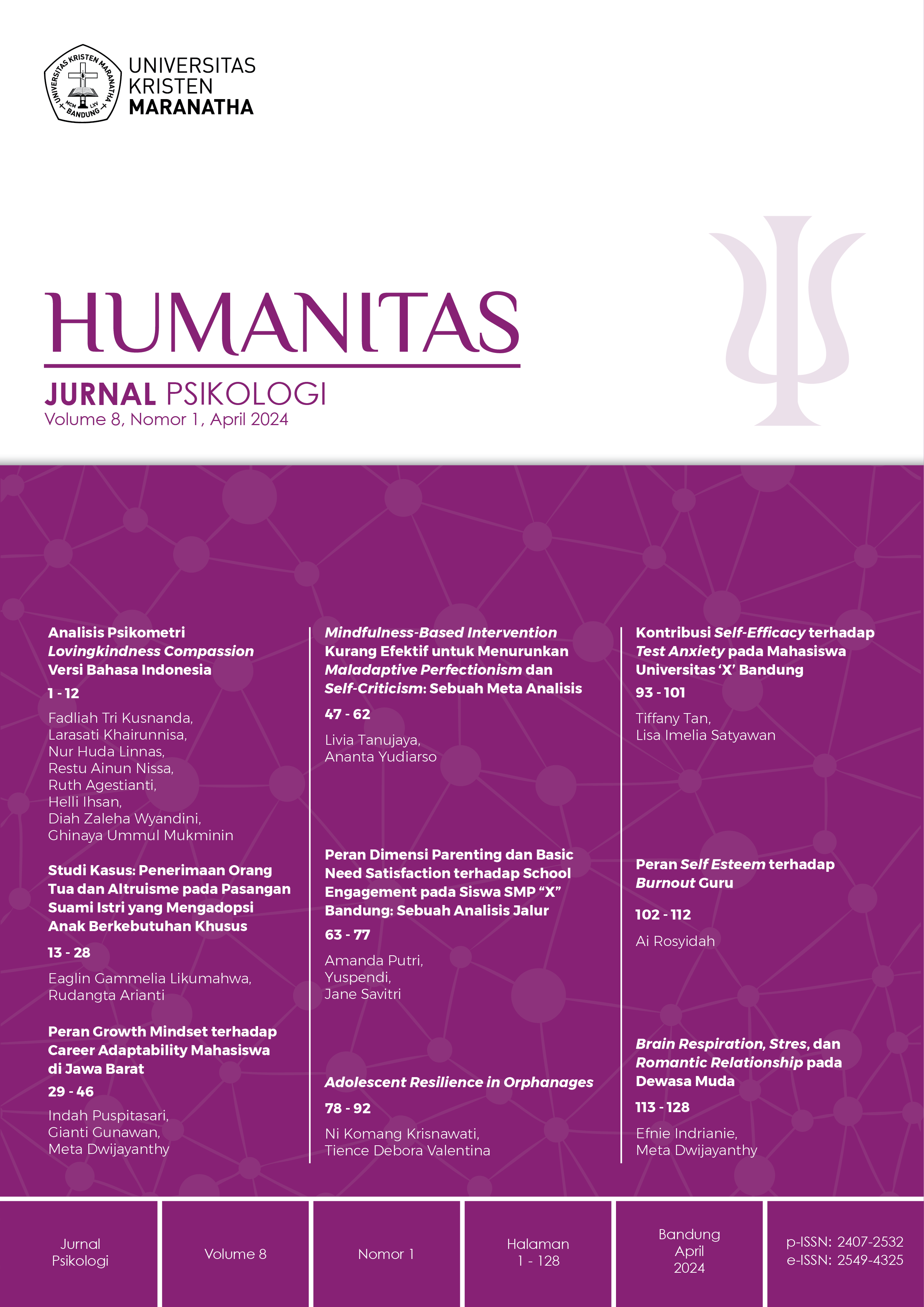Contribution of Self-Efficacy to Test Anxiety in 'X' University Bandung Students
Main Article Content
Abstract
Downloads
Article Details

This work is licensed under a Creative Commons Attribution-NonCommercial 4.0 International License.
References
Azwar, S. (2012). Penyusunan Skala Psikologi (Edisi Kedua). Yogyakarta: Pustaka Pelajar.
Azwar, S. (2015). Reliabilitas dan Validitas. Yogyakarta: Pustaka Pelajar.
Bandura, A. (1997). Self-Efficacy: The Exercise of Control. New York: W.H. Freeman and Company.
Benson, J. & El-Zahrar, N. (1994). “Further Refinement and Validation of the Revised Test
Anxiety Scale”. Dalam G. Marcoulides (Ed.), Structural Equation Modeling: A Mutidisciplinary Journal (1:3, 203-221). Oxfordshire: Taylor & Francis.
Deviyanthi, N. M. F. S. & Widiasavitri, P. N. (2016). Hubungan Antara Self-Efficacy dengan Kecemasan Komunikasi dalam Mempresentasikan Tugas di Depan Kelas. Jurnal Psikologi Udayana, 3:2, 342-353. https://doi.org/10.24843/JPU.2016.v03.i02.p16
Florencea, S. & Hapsari, E. W. (2019). Self-Efficacy dan Kecemasan dalam Menghadapi Tugas Akhir pada Mahasiswa UKWMS. Jurnal Experientia, 7:1, 55-67. https://doi.org/10.33508/exp.v7i1.2124
Hulukati, W. & Djibran, M. R. (2018). Analisis Tugas Perkembangan Mahasiswa Fakultas Ilmu Pendidikan Universitas Negeri Gorontalo. Jurnal Bimbingan dan Konseling Fakultas Ilmu Pendidikan Universitas Negeri Surabaya, 2:1, 73-114. https://doi.org/10 .26740/bikotetik.v2n1.p73-80
Imam, S. S. (2007).General Self-Efficacy Scale: Dimensionality, Internal Consistency, and Temporal Stability [Paper Presentation]. Proceeding of the Redesigning Pedagogy: Culture, Knowledge, and Understanding Conference, Singapore.
Salar, A.R., Baghaei, R. & Salah, E. (2016). The Survey of the Relationship Between Test Anxiety and Self-Efficacy Among the City of Urmia’s Medical Sciences University Students in 2016. International Journals of Medical Research & Health Sciences, 5:9, 591-595. https://www.ijmrhs.com/medical-research/the-survey-of-the-relationship-between-test-anxiety-and-selfefficacy-among-the-city-of-urmia-medical-sciences-university.pdf
Sarason, I.G. (1978). “The Test Anxiety Scale: Concept and Research”. Dalam Spielberger, C.D. & Sarason, I.G. (Eds.), Stress and Anxiety Volume 5 (193-216). Washington, DC: Hemisphere.
Sarason, I. G. & Sarason, B. R. (1990). “Test Anxiety”. Dalam H. Leitenberg (Ed.). Handbook of Social and Evaluation Anxiety (475-495). New York: Springer.
Siyoto, S. & Sodik, M. A. (2015). Dasar Metodologi Penelitian. Yogyakarta: Literasi Media Publishing.
Sugiyono (2007). Statistika untuk Penelitian. Bandung: Alfabeta.
Wisudaningtyas, A. (2012). “Kecemasan dalam Menghadapi Ujian Skripsi Ditinjau dari Self-Efficacy pada Mahasiswa Fakultas Psikologi Universitas Katolik Soegijapranata Semarang”. Lembaran Ilmu Kependidikan, 41:2, 89-92. https://doi.org/10.15294/lik.v4 1i2.2343
Zeidner, M. (1998). Test Anxiety: The State of the Art. New York: Plenum Press.

